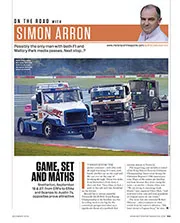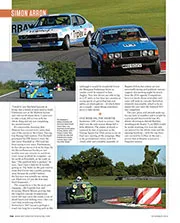

On the road with Simon Arron
Game, set and maths Snetterton, September 19 & 27: from ERFs to ERAs and Scanias to Austin 7s, opposites prove attractive t might just be the perfect commute – mile after…
The expense of competing in motor cycling competitions, the publicity attaching to them, and the technical lessons to be learnt, puts them on an entirely differ
ent plane to other sports. Most sports have a strict definition of an amateur, but there is no such definition in motor cycling. It is a democratic pastime, appealing, largely by its cheapness, compared with other fozin.s of motoring, to quite ordinary wage-earners. Very few motor cyclists have much cash to spare. Hence it has come to be accepted that a little assistance from the trade may be taken without in any way lowering the status of the rider. He thereby becomes a ” shamateur,” but what of that ? There are very few absolutely genuine amateurs in the more important motor cycling events. But they are none the less good sportsmen and enthusiasts.
It is difficult to arrive at any conclusion of value, because so many interests are involved, but in endeavouring to obtain an unbiased view of the situation, the following points must be borne in mind.
1. Cost is a relative matter ; relative to the value received. The T.T. is the most costly competition, yet it is obviously worth the expense, if only to maintain British supremacy.
2. Competitions are supposed to have lost their advertising value through the multiplicity of events. This is to some extent, true in so far as individual wins go : nobody pays very much attention if the Backslider wins the Golden Goblet, because the Crasher will probably win the Gilded Gudgeon-Pin next week. But a point which the trade seems to have missed is that collectively trials still have great value as propaganda for motor cycles in general.
Public Interest.
Although isolated complaints are heard concerning the noise caused by trials, the vast majority of the public is tolerantly amused and interested in the” race,” which, as may well be imagined, is an event of considerable importance in the humdrum life of remote country districts.
3. In the Provinces results still have some individual advertising value. In districts where trials are held, great interest is displayed in machines and their performances. All ” live” country agents are aware that a series of “good shows” in local trials will popularise a make enormously. Provincial buyers study results closely.
4. In the ” good old days” of unlimited boni, manufacturers used to send down a crack rider with a lorryload of works specials, to wipe the board at quite small hill climbs and trials. That always has been, and still would be, one of the best forms of local advertisement. 5. The manufacturers are following a lead set in the car world, but this is absolutely no guide whatever, for the conditions are so different. The car is more a utility vehicle, and for that reason may not need advertising by competitions. Motor cycling is essentially a sporting pastime, and for that reason alone, the more sporting
events there are, the better. The average Briton is a sportsman, and if he does not enter his motor cycle himself, he enjoys watching the experts’ displays.
6. Looking back over 9 or 10 years, can it honestly be said that the position or trend of motor cycling is any less sporting now than at any time ? Not a whit. New clubs are being formed, and trials entries were greater last year than ever before. Then why should public opinion in the matter suddenly change now, just because the manufacturers want it to, in order to provide them with a fresh market ? No, the sporting side of motor cycling is still the chief appeal, and competitions foster it. All this applies with still greater force to the export market, where ” utility ” riding is still less known.
A Bad Blow.
7. Trade riders feel pretty sore about it all, but the blow is felt perhaps even more by the impecunious amateurs who cannot afford to indulge in the sport without assistance. They have been providing the manufacturers of their machine and the sport in general with valuable publicity, fostering enthusiasm by the very fact that 200-300 of them will ride through the night in order to assault difficult hills in pouring rain. The spot of bonus they expect to touch, if successful, is only the ” quid pro quo” without which no business deal can be concluded. Now that it is dropped, entries will fall off enormously, enthusiasm will wane, and that will do the industry no good:
8. Besides, what does this bonus question boil down to, really ? Practically all the accessory makers have for long had agreements limiting the amounts and events they support, and these have been tightened up considerably of late. In open-to-centre trials, £2 10s. from Messrs. Wakefield or Vacuum was all the average amateur could expect, for a first-class award. Taking a whole season, it needed a pretty smart rider to clear, or even halve, his expenses.
Improving the Breed.
9. The technical value of trials has always hitherto been affirmed by the trade, even if it were not sufficiently obvious. Bigger tyres, reliable electric lighting, properly protected magnetos, are all attributable to trials. Manufacturers now say that they can test their products themselves, in private. But such tests will not have the same value. Comparisons form the truest test, and rivalry makes for quick progress.
The ban is the thin end of the wedge, designed at cutting out competitions as in the car world. The important point is that because the move has been successful with cars, there is no reason why it should be with motor cycles. The immediate ends, to reduce expense, will be gained ; but in the long run, the expense, which after all is borne ultimately by the purchaser, may prove the lesser evil.